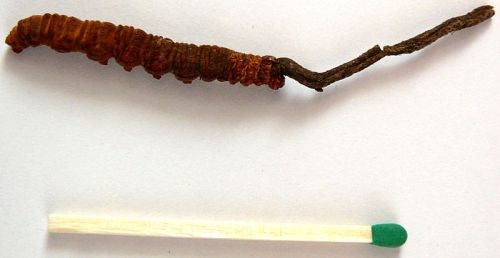by Piter Kehoma Boll
Most of you may have heard of those terrible fungi that turn poor insects into zombies, but did you know that one of them is used in China as food? Well, what is NOT used as food by the chinese, right? Anyway, that fungus is Ophiocordyceps sinensis (previously known as Cordyceps sinensis), but you may call it Chinese caterpillar fungus.
The fungus is known as caterpillar fungus because it infects larvae (caterpillars) of several ghost moths (family Hepialidae). The caterpillars live underground in meadows of the Tibetan Plateau and feed on the roots of many plant species. They eventually may become infected by spores of the fungus, which lead them to a terrible end. Inside the caterpillar, the fungus starts to grow, filling the host with threadlike hyphae and forcing it to move upwards, closer to the surface, where it dies with the head upwards. The fungus starts to grow out from the dead caterpillar’s head and forms a small bud. After winter has passed, the bud grows upwards, emerging from the soil and forming a stalking fruiting body that releases new spores in the environment. This is the stage in which the fungus is harvested by humans, together with the caterpillar.

The fruiting body of Ophiocordyceps sinensis emerging from the head of a dead caterpillar. Photo by Nicolas Merky.*
The fungus has several medicinal uses in Tibetan and Chinese medicine. It is considered to have aphrodisiac and anti-aging effects and is also used against cancer and to stimulate the immune system, as well as to treat respiratory and circulatory diseases, kidney and liver problems, fatigue, hyperglycemia, hyperlipidemia, asthenia and many other ailments. Chinese medicine considers it to have an excellent balance of yin and yang, as it is “both animal and vegetable”. Several bioactive metabolites were isolated from the fungi and some of them showed antimicrobial or antitumoral activity.
As a result of this panacea-like use, the fungus has been overharvested in its natural habitat and is currently considered an endangered species in China. It is, therefore, considerably rare nowadays, and its price may be higher than that of gold. The fungus may be cultivated in a liquid culture or in grains, but attempts to raise it inside caterpillars have been unsuccessful.
– – –
References:
Zhang, Y.; Li, E.; Wang, C.; Li, Y.; Liu, X. 2012. Ophiocordyceps sinensis, the flagship fungus of China: terminology, life strategy and ecology. Mycology 3 (1): 2–10. DOI: 10.1080/21501203.2011.654354
Wikipedia. Ophiocordyceps sinensis. Available at < https://en.wikipedia.org/wiki/Ophiocordyceps_sinensis >. Access on May 26, 2016.
– – –
* 
This work is licensed under a Creative Commons Attribution-ShareAlike 3.0 Unported License.

I always learn something new..! thanks for the article.
Does the fungus starts to grow from the head, filling the host with threadlike hyphae and forcing it to move upwards, closer to the surface, where it dies with the head upwards??
The fungal hyphae start by breeching the insects (hepialid grub for O. sinensis) cuticle and then spreading through the haemolymth(insect blood) into the organs. Once the grub is completely infected the cold weather of a Himalayan winter sets in and the grub crawls to near the top of the hole where it freezes and remains until the late spring and early summer when the club head (latin “cordyceps”) bursts through the dead grubs head and into the bright summer
Pingback: Friday Fellow: Fly-Killing Fungus | Earthling Nature